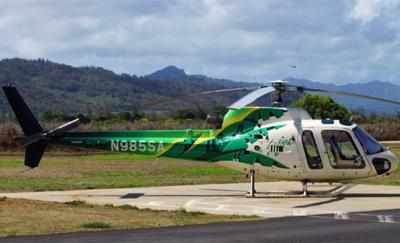Fri, May 13, 2022
NTSB Alleges FAA Could Have Prevented Tour Helicopter Crash
Earlier this week, the National Transportation Safety Board (NTSB) alleged that the Federal Aviation Administration (FAA) was negligent in preventing the fatal crash of an Air Tour Helicopter in 2019.

On 26 December 2019, an Airbus AS350 B2 helicopter that was being used for Air Tours by Safari Aviation crashed in Kekaha, Hawaii, killing the pilot and all six passengers after possibly entering instrument meteorological conditions (IMC).
The NTSB stated that as early as 2013, they emphasized [to the FAA] the need for more ‘flight information’ that they [NTSB] could use in possibly reconstructing the factors involved in accidents, and in drafting operating recommendations to avoid future recurrences. The NTSB also cited a general lack of up-to-date weather conditions, information about unusual/atypical weather, and lack of specialized in-flight weather training for air tour operators as factors that could have avoided the fatal crash of 2019.
Investigators stated that the air tour pilot was highly experienced who also served as the air tour company’s Chief Pilot and Check Airman, and still managed to get himself into a situation from which he could not recover. The terrain interference coupled with sparseness of weather observation systems, subsequently spotty radio communications and flight-tracking leaves a lot up to the pilot to evaluate as they go. You may recall the Civil Air Patrol crash on 29 March 2022 which had departed Lihue Airport and met its fatal end with two pilots aboard some 13 miles north in Kekhana. According to eyewitnesses, deteriorating weather was a contributing factor.
In the authors opinion, the NTSB appears to be using this incident to again push for the installation of flight data recorders. While the data recorders are good for evaluating after the crash, a more pressing need, it seems is the availability of real-time weather, information sharing, and training/awareness for the atypical/unusual weather common to the area.
More News
He Attempted To Restart The Engine Three Times. On The Third Restart Attempt, He Noticed That Flames Were Coming Out From The Right Wing Near The Fuel Cap Analysis: The pilot repor>[...]
Make Sure You NEVER Miss A New Story From Aero-News Network Do you ever feel like you never see posts from a certain person or page on Facebook or Instagram? Here’s how you c>[...]
From 2009 (YouTube Edition): Leading Air Show Performers Give Their Best Advice for Newcomers On December 6th through December 9th, the Paris Las Vegas Hotel hosted over 1,500 air >[...]
Aero Linx: NASA ASRS ASRS captures confidential reports, analyzes the resulting aviation safety data, and disseminates vital information to the aviation community. The ASRS is an i>[...]
“For our inaugural Pylon Racing Seminar in Roswell, we were thrilled to certify 60 pilots across our six closed-course pylon race classes. Not only did this year’s PRS >[...]
 NTSB Final Report: Rutan Long-EZ
NTSB Final Report: Rutan Long-EZ ANN FAQ: Turn On Post Notifications
ANN FAQ: Turn On Post Notifications Classic Aero-TV: ICAS Perspectives - Advice for New Air Show Performers
Classic Aero-TV: ICAS Perspectives - Advice for New Air Show Performers ANN's Daily Aero-Linx (06.28.25)
ANN's Daily Aero-Linx (06.28.25) Aero-News: Quote of the Day (06.28.25)
Aero-News: Quote of the Day (06.28.25)



